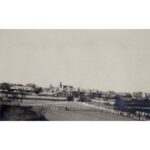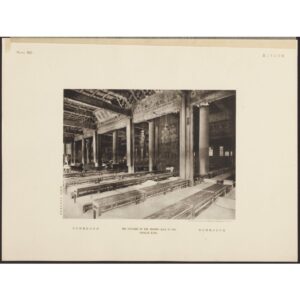Photography The Official Entrance to the Austro-Hungarian Legation
A black-and-white photograph showing the main entrance of the Austro-Hungarian embassy or legation in the Diplomatic Legation Beijing (Dongjiaominxiang 東交民巷). The latter was situated between 1861 and 1959 in the area of theI Inner City (Neicheng 内城), east of present-day Tiananmen Square (Tiananmen Guangchang 天安門廣場), and south of the Forbidden City (Gugong 故宫 or Zijincheng 紫禁城). The territories of each legation were surrounded by a wall. Access to the legation was possible at certain points through a designated portal and guardhouse, above which the national flag was hoisted.
In 1869, Austria-Hungary also signed a trade agreement with the court in Beijing that was unfavourable to China. Soon after, the Viennese court opened its representative office in Beijing in a small mansion, which was converted into an embassy in 1896. The renovation of the embassy building, which was severely damaged during the Boxer Rebellion, was led by the Slovenian-born ... more
A black-and-white photograph showing the main entrance of the Austro-Hungarian embassy or legation in the Diplomatic Legation Beijing (Dongjiaominxiang 東交民巷). The latter was situated between 1861 and 1959 in the area of theI Inner City (Neicheng 内城), east of present-day Tiananmen Square (Tiananmen Guangchang 天安門廣場), and south of the Forbidden City (Gugong 故宫 or Zijincheng 紫禁城). The territories of each legation were surrounded by a wall. Access to the legation was possible at certain points through a designated portal and guardhouse, above which the national flag was hoisted.
In 1869, Austria-Hungary also signed a trade agreement with the court in Beijing that was unfavourable to China. Soon after, the Viennese court opened its representative office in Beijing in a small mansion, which was converted into an embassy in 1896. The renovation of the embassy building, which was severely damaged during the Boxer Rebellion, was led by the Slovenian-born architect Ivan John Jager. Since Austria-Hungary was involved in the suppression of the Boxer Rebellion, it received so-called concessions in the city of Tianjin from China in 1902 for the damages suffered.
The photograph is the 17th of 449 photographs of Beijing and its surroundings in the album of Ivan Skušek Jr., purchased during his stay in Beijing (1914–1920). In the handwritten inventory of the album, the photograph is referred to as Oest. eng. Gesandtschaft: Tor. (DZ)





































Do you have a comment or additional information about the subject?